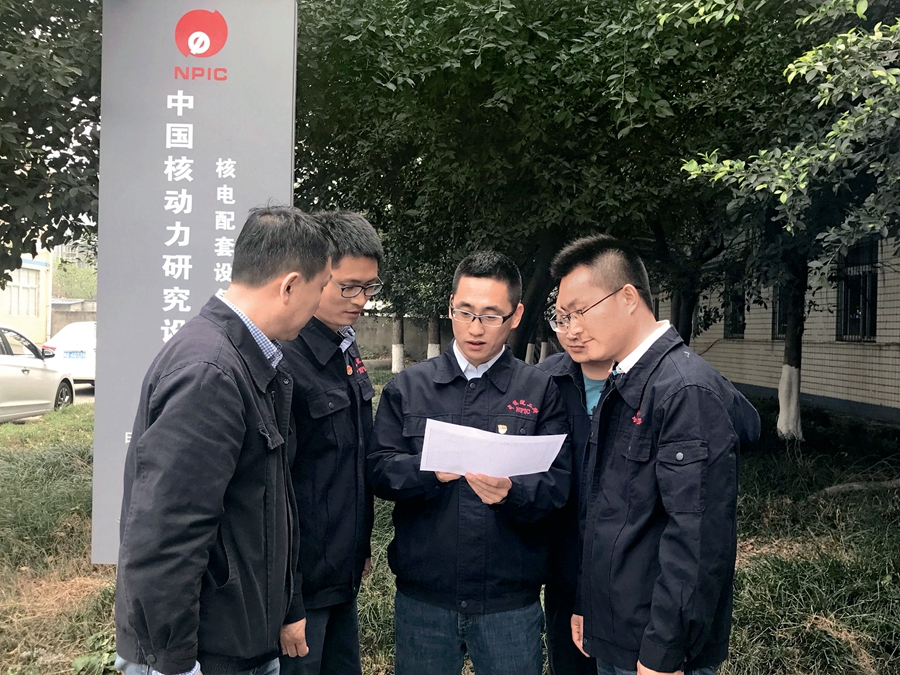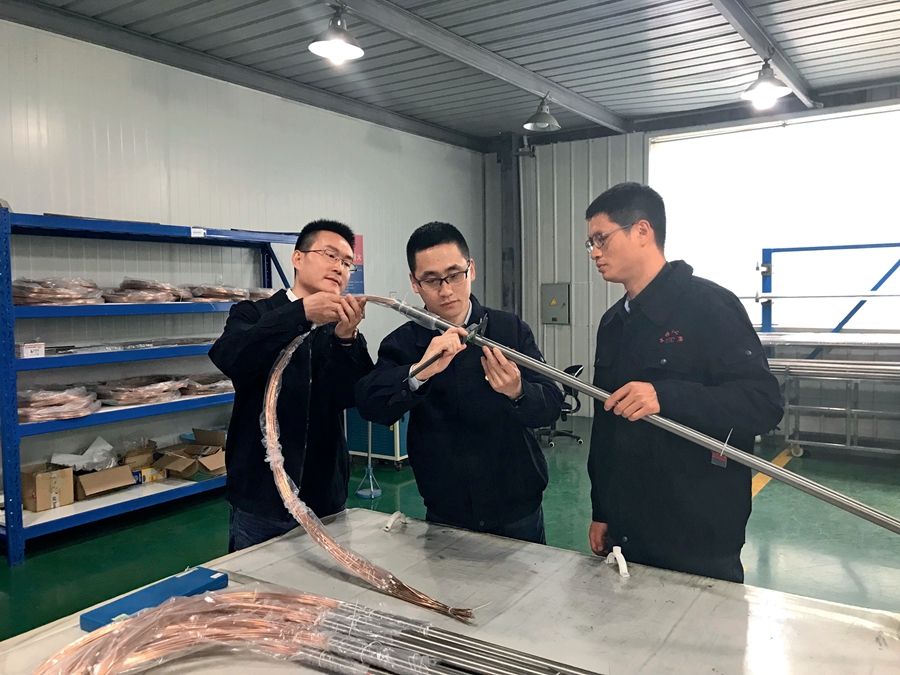By TU TIAN
By TU TIAN
THE third-generation nuclear power technology independently developed by China is a significant symbol of Chinese manufacturing capacity. This achievement comes from the dedication and pioneering spirit of those working in this field. Among them are Wang Guangjin and his team at the Nuclear Power Institute of China (NPIC).
Ending Foreign Monopoly
Wang is currently deputy chief of the No. 2 Institute of the NPIC. Upon finishing his doctorate program in 2005, he joined the NPIC’s nuclear reactor research arm to develop electrical penetration assemblies (EPAs).

Wang Guangjin (center) and his team.
“I majored in chemical machinery in university. Before I came to the NPIC, its leadership learned that a device used in power stations could not be produced locally. Imports were expensive, and the necessary technologies were barred from China. The institute intended to work on it, so my first task here was to develop EPAs,” Wang recalled. His field of study for the doctorate program – macromolecular materials – was relevant to this task, which required breakthroughs in the selection and application of new materials.
Due to the blockade on relevant technologies by foreign countries and lack of reference designs or samples, Wang and his team had to start from scratch, and forged their own way forward in their research.
Under tight schedules and poorly equipped, for two months in the summer of 2007, Wang drafted designs during the day and conducted tests at night in an electric cable factory. He took part in every step of the process, including cleaning the machine, grinding the crankshaft, and repeatedly compared the parameters. To completely remove the coating material on it, the crankshaft must be cleaned and ground under high temperatures and with manual work. One day a searing hot crankshaft fell off the table in the process, without hesitation Wang caught it with his hands, which caused a severe burn on his right hand.
After three years of trial and error, Wang and his team mastered six critical technologies which eventually led to the development of Chinese made EPAs. They then went on to make more innovations to upgrade the technologies, which equal and in some aspects, even exceed those of other countries. This milestone advancement is critical for China’s independent development of the third- and fourth-generation nuclear power technologies.
In June 2010, Chinese manufactured EPAs entered mass production, and began to supply domestic nuclear power units. In 2015 they were ordered by Tecnatom of Spain, hence making their debut on the European market. In March 2017 they were upgraded to the third generation.
From Development to Production
Many researchers find it difficult to bring samples into industrial scale production. After the successful development of EPAs, Wang took on the role of chief technician for their supply to the market, and dedicated himself to manufacturing and product quality.

Wang Guangjin (center) and his colleagues during a quality-control test of a key component.
On the basis of his experience in the development stage, Wang masterminded the overall project planning and technical planning, and worked out standardized operation of the whole process of design, manufacturing, testing, and quality assurance. He also designed training courses, compiled teaching materials, and gave lectures to workers to ensure they would well understand the product design and deliver the best possible quality. What’s more, by closely monitoring the production process and widely soliciting opinions of relevant parties, Wang published 90-plus technical papers on design output, engineering construction and change control, and set eight corporate standards on product design, manufacturing, testing, and raw materials.
During the trial production period Wang spent long hours in the factory to gain firsthand knowledge of the production and solve on-site problems that arose in the process. He took every problem seriously to prevent it from recurring after formal production. In less than one year, the production process passed the assessment by experts, and started commercial supply to the market.
The Marathoner’s Spirit
Wang spurred himself with the marathoner’s spirit in his work. This spirit of challenging oneself and pushing one’s limits, he said, is reflected in China’s independent development of EPAs. In fact, during the development process Wang set up a marathon team, and became its leader.
“Marathon is known for its long distance and the great endurance it requires. It seems a tedious sport that is no more than the alternating of two feet. But it is actually a game of science, as one can only run the distance after rigorous, scientific, and dedicated training,” said Wang. “This is the same with my job. Without dedication, perseverance, scientific planning, and rigorous implementation, we can achieve nothing.”
Zheng Lanjiang, a member of the research team of EPAs, was Wang’s teammate. He was impressed with Wang being scrupulous about every detail. “He required us to seek perfection on all matters, big or small. This shaped the work environment of our team,” Zheng recalled. “An impressive example is the compilation of a handbook on product specifications. I made eight rounds of amendments before handing it in. All members of the team tried to refine their papers to the point that they could answer any question Director Wang may ask in the reviewing process.”
The marathoner’s spirit of challenging oneself and pursing perfection has encouraged Wang and his team to accomplish seemingly impossible tasks one after another in the field of nuclear power research and innovation. In addition to EPAs, they have developed a number of sophisticated devices used in nuclear reactors, such as the leakage monitoring system based on leak-before-break (LBB) technology, hydrogen monitoring system, loose parts monitoring system, vibration monitoring system, CRDM power supply system, temperature and humidity instrument, and brought them into mass production. Their multiple technical breakthroughs led to the upgrading of relevant products and adoption of new materials and new technologies. So far, the team has received over 20 patents.
Craftsmanship
Recently receiving the honor of the Sichuan Craftsman, a title for people outstanding in a particular profession, Wang had his own take on the word “craftsmanship.” “When people talk of craftsmanship, it is more about passing down this spirit through teaching by words and deeds. But in my organization, when the team grows, we need procedural guidance and institutional restraints in addition to teaching by words and deeds to create an environment of perfectionist craftsmanship. Only in doing so can we ensure the unity of the team in terms of professional level, ethos and morale.”
Wang recognized that teaching by words and deeds is necessary in promoting craftsmanship. But keeping in mind the requirements for employees in modern enterprises, it has to be combined with due procedures and institutions to foster the corporate culture that can bring craftsmanship to fruition.
“The situation of the field we are in and the nature of the nuclear industry determines that we cannot solely rely on experience,” Wang explained. “The attitude of dedication and concentration can be taught by words and deeds, but key technologies and essential matters cannot. We therefore need procedural guidance and institutional restraints.”
Wang is leading his team to make innovations in this respect. “By carrying out the spirit of craftsmanship, we will improve quality control procedures and management procedures. One measure we have introduced this year is experience-based feedback. Once a problem is spotted in a product, it must be reported to other teams involved in the project, so that it will not happen again. The method and result of amendment should also be shared by all relevant teams. We need both innovative management and lean management.”
TU TIAN is a China Daily reporter.